Microsoft ends support for Internet Explorer on June 16, 2022.
We recommend using one of the browsers listed below.
- Microsoft Edge(Latest version)
- Mozilla Firefox(Latest version)
- Google Chrome(Latest version)
- Apple Safari(Latest version)
Please contact your browser provider for download and installation instructions.
October 5, 2023
NTT Corporation
World's First Successful 1.6 Tbit/s Optical Transmission Experiment with Multi-core Fiber Cable Installed in a Field Environment
- Promising Technology for Achieving Large-capacity Ethernet in Large-scale Data Centers -
NTT Corporation (Headquarters: Chiyoda-ku, Tokyo, President & CEO: Akira Shimada, "NTT") has successfully performed the world's first*1 optical-signal space
multiplexing*2 optical transmission experiment (referred to below as "this experiment") exceeding 1.6 Tbit/s per fiber using field-installed 4-core fiber based on the Intensity Modulation and Direct Detection (IMDD)*3 method.
This experiment demonstrated the transmitting/receiving of IM-DD optical signals exceeding 400 Gbit/s per lane in an Ethernet-standard wavelength band (O band) and as a world's first successfully performed a 10 km transmission of ultra-high-speed IM-DD signals at 1.6 Tbit/s per fiber in a field environment. This result was made possible by sophisticated merging of an NTT-developed ultra-wideband baseband amplifier IC module*4 with ultra-high-accuracy digital signal processing technology and space multiplexing transmission technology using multi-core fiber.
By demonstrating large-capacity transmission greater than four times that of the current practical level, this result indicates the possibility of improving the scalability of large-scale data center networks as a core technology of next-generation Ethernet.
Details of this technology were accepted as the top-scored paper*5, and most highly evaluated by the reviewers in the transmission section of the international conference ECOC2023 (European Conference on Optical Communications) to be held in Glasgow, UK from October 1, and will be presented on October 5 (local time). Some of these research results were obtained through commissioned research (adoption number 20301) of the Advanced Communications and Broadcasting Research and Development Project of NICT.
1. Research Background
The upward trend in communications traffic is predicted to continue due to the explosive increase in video data streaming, expansion of cloud services, and spread of 5G services in recent years. In parallel with this trend, traffic within and between data centers is expected to increase as a massive number of users attempt to access data center services.
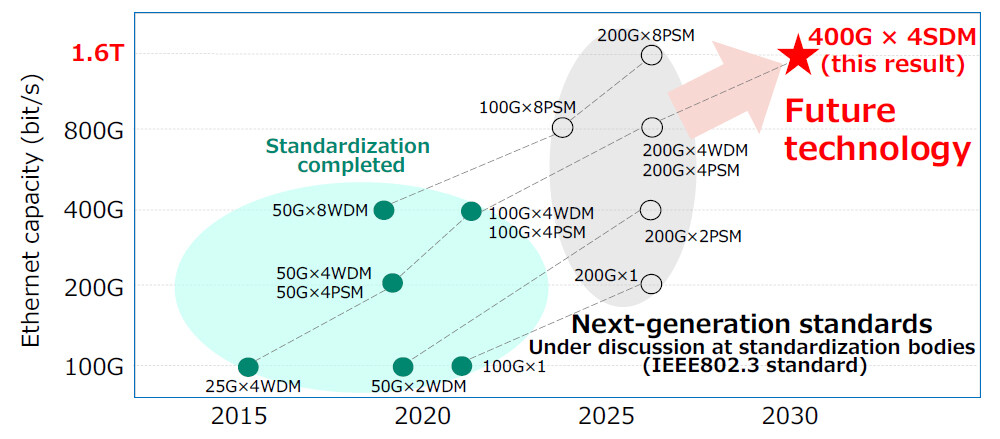 Fig. 1 Ethernet standardization trends
Fig. 1 Ethernet standardization trends
2. Technical Issues
Ethernet standards are applied as a data-signal transmission method in data center networks, and standardization of transmission speeds up to 400 Gbit/s has been completed in the form of the IEEE802.3 standard. At the same time, discussions have begun on 800 Gbit/s and 1.6 Tbit/s Ethernet standards (Fig. 1). First, modules based on the latest Ethernet standards are being aggressively deployed in data center networks, where network traffic is growing rapidly, and as the standards mature, modules are being used in a wider network infrastructure. Large-scale data center networks of the future will require 1.6 Tbit/s large-capacity Ethernet, and to achieve this level in an economical manner, it will be necessary to increase transmission speed to 400 Gbit/s per lane and perform parallel transmission with a small number of lanes (four lanes) in a single fiber while maintaining the transmission distance in the existing standard. Current technology and issues that must be considered in setting out to achieve this goal are listed below.
Current technology
- Many Ethernet standards provide for parallel transmission by the multi-lane distribution method to achieve high-speed Ethernet communications. For example, the transmission of 400 Gbit/s Ethernet signals is achieved by transmitting four 100 Gbit/s signals per lane in parallel. Parallel transmission methods include Wavelength Division Multiplexing (WDM)*7 using multiple wavelengths and Parallel Single Mode Fiber (PSM)*8 using multiple optical fibers.
- In Ethernet, the Intensity Modulation and Direct Detection (IM-DD)*3 method that transmits data signals via a simple transmitting/receiving structure has been used as an economically effective means of performing communications.
- In Ethernet, standards for transmission distances of 2 km, 10 km, 40 km, etc. have been established, and future large-scale data center networks will require transmission distances of 10 km to provide broad support for Ethernet connections both within and between data centers.
- The latest Ethernet standard achieves 100 Gbit/s signals per lane by IM-DD using a symbol rate*9 of approximately 53 Gbaud in Pulse Amplitude Modulation (PAM)*10 4-level (PAM4).
Issues
- To increase the speed up to 400 Gbit/s per lane using PAM4 the same as before, it will be necessary to increase the signal symbol rate to more than 200 Gbaud. Transmitting such ultra-high-speed signals with high quality will require a wideband electrical amplifier (driver amplifier for the optical modulator) in the optical transmitter and receiver.
- This will require digital signal processing technology on the receiver side to perform extremely accurate compensation of signals that have been distorted within optical transmitters and receivers and along the optical fiber transmission path in conjunction with higher signal speeds. It has been difficult to transmit/receive 400 Gbit/s per lane signals using existing technology.
- In such ultra-high-speed signals, the effects of waveform distortion that arise along the optical fiber transmission path are proportional to the square of the symbol rate (modulation rate) and are extremely noticeable resulting in significant degradation of signal quality. As a result, achieving a transmission distance of 10 km by multiplexing four different wavelengths in one existing optical fiber using a conventional method (WDM) has been difficult.
3. Research Result
In this research, we demonstrated the transmitting and receiving of IM-DD optical signals exceeding 400 Gbit/s per lane in an Ethernet-standard wavelength band (O band) (Fig. 2, left) and successfully performed as a world's first a 10 km transmission of ultra-high-speed IM-DD signals at 1.6 Tbit/s per fiber in a field environment (Fig. 2, right). This result was achieved by sophisticated merging of an NTT-developed ultra-wideband baseband amplifier IC module with ultra-high-accuracy digital signal processing technology and space multiplexing transmission technology using multi-core fiber.
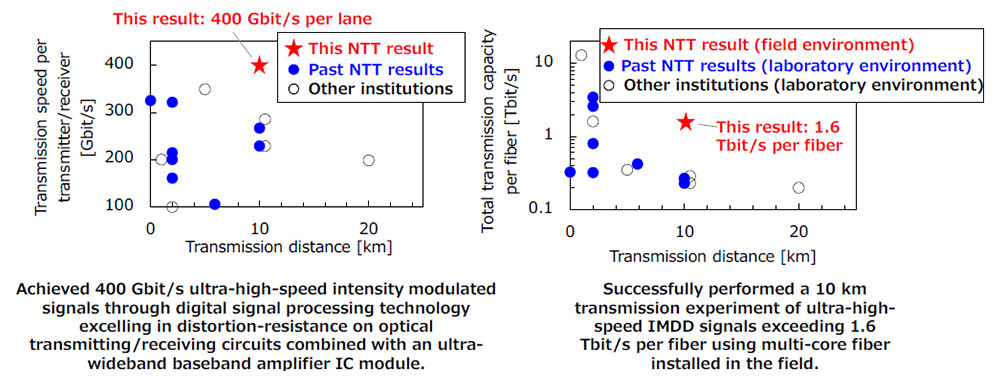 Fig. 2 The results this time and conventional technology (*1)
Fig. 2 The results this time and conventional technology (*1)
4. Future Prospects
By increasing transmission capacity by more than four times that of the current practical level, this technology is expected to transmit Ethernet signals with high reliability at speeds exceeding 1.6 Tbit/s per fiber at large-scale data center networks of the future. This development should make it possible to cope with the explosive increase in communications traffic brought on by the expansion of cloud services and spread of 5G services.
With a view to achieving an All-Photonics Network (APN) in IOWN*6/6G, research and development efforts at NTT seek to deepen the merging of its original device technology with digital signal processing technology and optical transmission technology.
Appendix: Technical Details of this Research
3.1 Technology for transmitting/receiving ultra-high-speed IMDD signals at 400 Gbit/s per lane
In research and development to date at NTT, we have applied an ultra-wideband baseband amplifier IC module*4 as a driver amplifier for optical modulators in optical transmission circuits to support frequencies up to 100 GHz based on indium phosphide-based heterojunction bipolar transistor (InP HBT)*11 technology. Additionally, by applying the PAM8 method that can decrease the symbol rate by 3/4 compared to conventional PAM4, we have made it possible to generate stable ultra-high-speed IM-DD optical signals (155 Gbaud PAM8) at 400 Gbit/s per lane (Fig. 3, lower left (1)). Here, the receiver side simulates with high accuracy signal distortion within optical transmitters and receivers and along the transmission path by digital signal processing using nonlinear maximum likelihood sequence estimation*12 based on NTT-developed digital signal processing technology. Then, by comparing this simulated signal with the received signal, the bit error rate (BER) of the received signal can be significantly reduced enabling the high-quality reception of ultra-high-speed PAM8 signals at 400 Gbit/s per lane (Fig. 3, lower right).
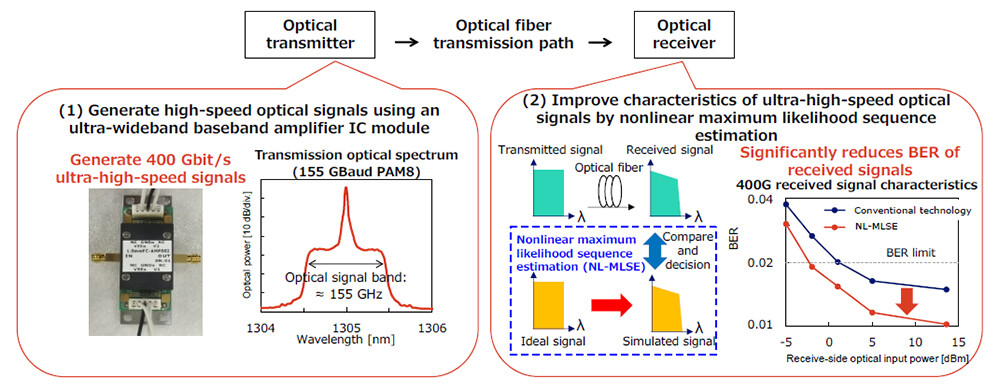 Fig. 3 Technology for transmitting/receiving ultra-high-speed IMDD signals at 400 Gbit/s per lane
Fig. 3 Technology for transmitting/receiving ultra-high-speed IMDD signals at 400 Gbit/s per lane
3.2 Demonstration of 10 km multi-core-fiber transmission of ultra-high-speed IM-DD signals at 1.6 Tbit/s per fiber
The transmission/reception of ultra-high-speed IM-DD optical signals at 400 Gbit/s per lane has become possible through an ultra-wideband baseband amplifier IC module based on NTT-developed InP HBT technology and nonlinear maximum likelihood sequence estimation. Therefore, to achieve a 1.6 Tbit/s signal, it is necessary to transmit four 400 Gbit/s ultra-high-speed IM-DD signals in parallel. However, the effects of signal waveform distortion, which is caused by wavelength dispersion*13 and other factors occurs along the optical fiber transmission path, is particularly noticeable with high-speed signals. This makes it difficult to transmit four 400 Gbit/s per lane signals in parallel along one existing optical fiber using the WDM method that has been used up to now in data center networks.
The R&D achievement presented here solves this problem by adopting space multiplexing using multi-core fiber. Specifically, by allocating one wavelength per core, we made it possible to set a wavelength that cannot be easily affected by wavelength dispersion in each of four cores. Furthermore, by enhancing the optical signal format from the conventional four levels (PAM4) to eight levels (PAM8) and thereby decreasing the symbol rate by 3/4 compared to PAM4, and by combining this with signal processing using nonlinear maximum likelihood sequence estimation, we succeeded in greatly decreasing signal waveform distortion due to wavelength dispersion.
Additionally, by laying 4-core fiber cable in underground facilities on the premises of NTT Laboratories, the multi-core fiber used in this experiment simulated an actual cable-installed environment (Fig. 4). This 4-core fiber adopts the same cladding diameter (125 µm)*14 as existing fiber, and since each core takes on a simple step-index type of refractive-index structure the same as existing fiber, we can assume a structure applicable to mass production. The optical characteristics of each core are equivalent to those of existing international standards for optical fiber, and we have succeeded in decreasing the variation in characteristics in each core compared with the PSM method using individual fibers. In addition, the inter-core crosstalk (the amount of light leaking in from neighboring cores) in a 10 km transmission was approximately 1/100,000 in the 1.3 µm wavelength Ethernet standard band (O band) used by the IM-DD method, so we succeeded in deceasing crosstalk to a level having absolutely no effect on optical signal transmission.
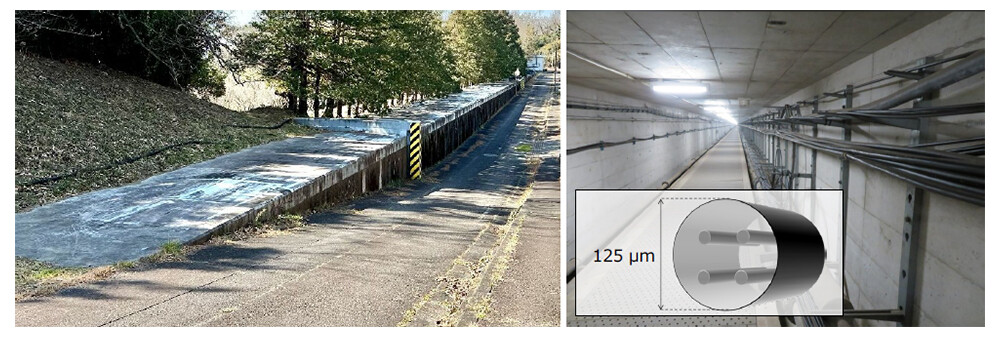 Fig. 4 Fiber installation environment within NTT Laboratories, underground facilities, and cross-section of multi-core fiber
Fig. 4 Fiber installation environment within NTT Laboratories, underground facilities, and cross-section of multi-core fiber
As a result, we successfully conducted the world's first optical transmission experiment of ultra-high-speed IM-DD signals exceeding 1.6 Tbit/s per fiber over a distance of 10 km in a field environment (Fig. 5). This has been accomplished by space multiplexing transmission of four ultra-high-speed signals at 400 Gbit/s per lane in parallel using field-installed multi-core fiber and applying nonlinear maximum likelihood sequence estimation to the PAM8 method to reduce BER.
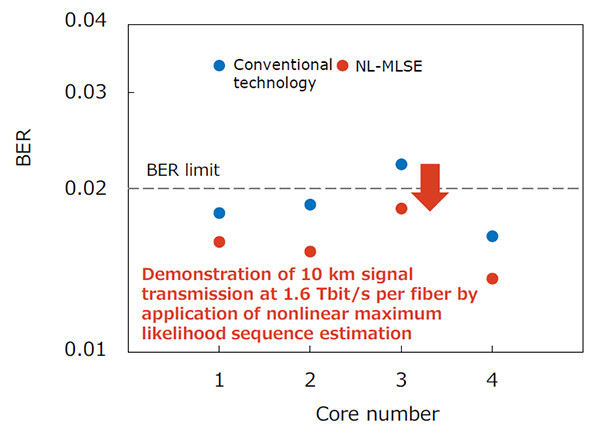 Fig. 5 Results of 10 km transmission of ultra-high-speed IM-DD signals at 1.6 Tbit/s per fiber
Fig. 5 Results of 10 km transmission of ultra-high-speed IM-DD signals at 1.6 Tbit/s per fiber
Support for this Research
A portion of these research results were obtained through research commissioned by the National Institute of Information and Communications Technology (NICT) as part of the Advanced Communications and Broadcasting Research and Development Project (adoption number 20301).
【Glossary of Terms】
*1According to NTT's survey as of October 2023. Based on experimental results in an Ethernet-standard wavelength band (O band) used by the Intensity Modulation and Direct Detection (IMDD)*3 method.
*2Space multiplexing:
A method for spatially transmitting signals in parallel within a single optical fiber using either a multi-core fiber having multiple cores (optical signal paths) in a single optical fiber or a multi-mode fiber in which light propagates in multiple modes. This method can achieve a dramatic increase in communications capacity. In this experiment, we performed space-multiplexing transmission using 4-core multi-core fiber installed in underground facilities on the premises of NTT Laboratories.
*3IM-DD:
Method for encoding information in optical intensity with respect to transmission wavelength. It can be configured using only a semiconductor laser, external optical modulator, driver amplifier, and optical detector thereby facilitating the development of simple and low-cost optical transmitters and receivers.
*4Ultra-wideband baseband amplifier IC module:
A module that mounts an NTT-developed ultra-wideband baseband amplifier integrated circuit (IC) module having the world's widest bandwidth in a package equipped with a 1 mm coaxial connector supporting frequencies up to 110 GHz. Achieves an amplifier IC applying NTT-developed high-precision circuit design technology and new bandwidth-enhancing circuit architecture technology based on InP HBT*10 technology
NTT Press Release: "NTT Achieves the World's Greatest Bandwidth of 241 GHz for an Amplifier IC — Shows Promise as General-purpose Ultra-high-speed Device Technology for Next-Generation Data Centers and Beyond 5G —"
https://group.ntt/jp/newsrelease/2019/06/03/190603b.html
*5Top-scoring papers:
The paper with the highest average score among the papers submitted to each research field of the International Conference on Optical Communication Technology held in Europe every year, which was scored by all the committee members in the division.
*6IOWN (Innovative Optical and Wireless Network):
NTT Press Release: Regarding the announcement "NTT Technology Report for Smart World: What's IOWN?" https://group.ntt/jp/newsrelease/2019/05/09/190509b.html
*7WDM:
Method for transmitting signals in parallel using multiple wavelength channels.
*8PSM:
Method for transmitting signals in parallel using multiple optical fibers.
*9Symbol rate:
The number of times the optical waveform switches per second where Baud is the unit of measurement. The 155-gigabaud (GBaud) optical signal achieved in this experiment transmits information by switching the optical waveform 155 billion times per second.
*10PAM:
A method for encoding information in multiple intensities on an optical signal. The PAM4 and PAM8 methods transmit/receive signals using four different optical intensity levels and eight different optical intensity levels, respectively.
*11InP HBT:
A heterojunction bipolar transistor excelling in high-speed and pressure-resistant characteristics using indium phosphide, a III-V group semiconductor.
*12Nonlinear maximum likelihood sequence estimation:
Maximum likelihood sequence estimation is a technique for enhancing the accuracy of signal judgment by comparing multiple received signals (signal sequences) with multiple candidate sequences that simulate received signals. NTT's original nonlinear maximum likelihood sequence estimation technique can further enhance the accuracy of signal judgment by reflecting nonlinear distortion — waveform distortion that arises in optical transmitters and receivers and along the transmission path changes in a complex manner according to input intensity — in candidate signal sequences in maximum likelihood sequence estimation.
*13Wavelength dispersion:
Wavelength dispersion is the phenomenon in which the velocity of light propagating through optical fiber differs for each wavelength. In ultra-high-speed signals, since the bandwidth of transmitted signals broadens and propagation velocity differs for each of those wavelength components, the effects of signal distortion due to wavelength dispersion are notable.
*14Cladding diameter conforming to international standards:
To facilitate mass production and maintain interconnectivity, international standards specify the diameter (cladding diameter) of optical fiber currently used in optical communications to be 125 ±0.7 μm and the diameter including the outer jacket for protecting the optical fiber to be 235 - 265 μm.
Media contact
NTT
Public Relations
nttrd-pr@ml.ntt.com
Information is current as of the date of issue of the individual press release.
Please be advised that information may be outdated after that point.
NTT STORY
WEB media that thinks about the future with NTT










